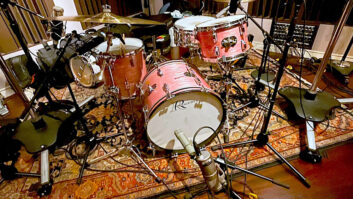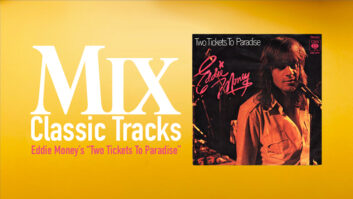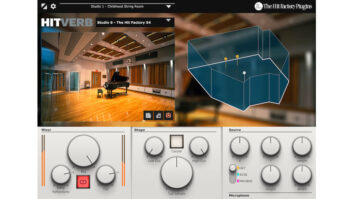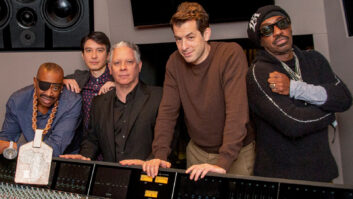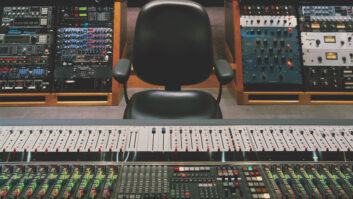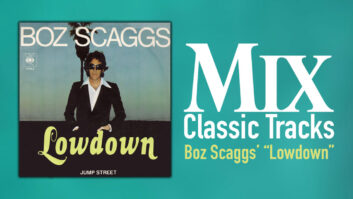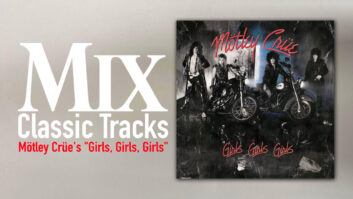“We left the parking lot for last. We wanted to get the music happening.” So said Troy Germano, executive vice president of The Hit Factory, as he surveyed the final stages of the company’s foray into Miami. Criteria Recording Studios, a legendary south Florida facility that has seen countless hits during the past 40-plus years, has now merged with The Hit Factory, one of New York’s most successful studios. The result is a renovated complex the likes of which Miami has never seen.
The Hit Factory closed the deal to acquire Criteria on January 12, 1999, after two months of negotiation with then-owner, Joel Levy, whose family had purchased the facility from its founder, Mack Emerman, ten years earlier. After a six-month pause, the Germano family, The Hit Factory owners, began a phased rebuilding and renovation program that was completed in March 2000. Located near Biscayne Boulevard in northwest Miami, Hit Factory Criteria now has six full studios, including a large scoring room; a mastering studio; a digital audio editing suite; several pre-production rooms; and a host of other enhancements, technical, acoustical and aesthetic. Replete with African slate floor tiles and Italian porcelain fixtures, the environs are as palatial as those of its new northern parent.
“The interesting thing about it is that we really tried hard-and succeeded, I believe-in bringing Criteria up to the level we’ve achieved in New York, in terms of being the best a recording studio can be and still keeping the things that made [Criteria] a magical place for so long,” Troy Germano says.
THE LEGACIESThere was a lot of heritage, both north and south, to balance and integrate. The Hit Factory was founded by legendary producer and composer Jerry Ragavoy in the late 1960s, and it was one of a generation of facilities-including Phil Ramone’s A&R Studios and Jimi Hendrix’s Electric Lady Studios-that came to reflect the increasing power of the independent producer and artist in rock music during that period. In 1975, The Hit Factory was sold to producer and entrepreneur Ed Germano, who built it into what is arguably the most successful multiroom facility in New York and possibly in the country. The Hit Factory’s ten studios and four mastering rooms in two locations on Manhattan’s West 54th Street house a large array of cutting-edge technology, housed in sumptuous surroundings. Many of music’s elite, such as Billy Joel, Whitney Houston and Mariah Carey, have been long-standing patrons of The Hit Factory, a reflection of Ed Germano’s simple, but apparently effective, strategy of building solid relationships over long periods of time.
Criteria Recording is older by two musical generations, at least. It was founded by Emerman as a one-room facility in 1958. The studio was an outgrowth of his avid pursuit of jazz recordings, which he began from the back of his station wagon in South Florida when Miami was home to music recordings by Arthur Godfrey and Jackie Gleason. By the early 1970s, Criteria had become the site of numerous recordings that are now regarded as classics, including Derek & the Dominos’ Layla, The Eagles’ Hotel California and parts of Fleetwood Mac’s Rumours. Its five studios were often booked for years at a stretch by artists like Eric Clapton and the Bee Gees.
REBUILDING FROM THE INSIDE OUTCreating the new facility was a nine-month odyssey that began in the summer of 1999, starting with a design by David Bell of UK-based Whitemark, an independent offshoot of the former Harris Grant Design. (Neil Grant designed the new Hit Factory in Manhattan, which opened in 1993.) The plans called for keeping each of the existing five studios in their original locations throughout the nearly 30,000-square-foot, low-rise structure, but significantly rebuilding the rooms. Starting with the basic acoustical shell, the intent was to dramatically improve what had been less-than-ideal acoustical isolation between the original studios, as well as to add tielines connecting all studios and their machine rooms, update the electrical and HVAC systems, and import completely new aesthetics, conceived largely by Ed Germano.
The design was implemented on a rolling construction schedule and allowed existing studios on one side of the building to continue holding sessions as rooms on the other side underwent reconstruction. The largest room, Studio A, came online last.
The big addition to the former Criteria is Studio F, created from what had been an entrance foyer and a billiards lounge. The all-digital Studio F holds a 120-channel Sony OXF-R3 Oxford digital console, with a Sony 3348HR multitrack, a dedicated 24-bit Pro Tools system, and everything else down to the Weiss digital EQ and dynamics processors. The stark technical design is offset by the cherry-wood RPG Diffusors that line the walls of the control room, and the subtle and varied color schemes of the control room and its adjacent overdub spaces. A clever curved-rail system allows the near-field speakers to glide to any position in the monitoring field-front and rear-in the 6-channel all-digital mixing suite. For consistency throughout the facility, main monitoring consists of George Augspurger components in custom-designed soffitted enclosures and large soffitted subwoofers designed by Matt Dobson. Individually floated concrete flooring slabs are common to all of the control rooms.
“We wanted to have a 5.1 environment with large-format speakers,” explains Roger Charlesworth, director of technical development for the facility.
“But it’s also a room where people are going to be spending 18 hours at a time, so we wanted to make it comfortable and have some fun with the colors,” Troy Germano interjects. He points out subtle points of the lighting and the cloth wall coverings that reveal his father’s eye for detail. “It kind of plays to the South Florida vibe down here, but without going totally art deco.”
Studio C-the midsized, high-ceilinged (20x30x19) studio in which Hotel California, Rumours and the Saturday Night Fever soundtrack were recorded-is in the same wing as Studio F and features a vintage 40x24x32 Neve 8078, one of the few consoles retained from the original Criteria. (The console was originally in Studio A.) The board was extensively modified by Neve retrofit specialist Fred Hill with such technical amenities as a new center section with balanced mix buses.
“Studio C is one of the rooms here that really shows how hard we worked to keep what made Criteria great in the first place,” Charlesworth says. “Actually, it would have been a lot easier to start with an empty space to build what we have here. We had to work within what was already defined by the [existing] studio space. We kept the studio’s footprint, but everything, from the flooring to the actual isolation shell, is completely new. The new footing goes down 3 feet below the floor level.” Some of the nicer touches include four permanently mounted B&K 4053 microphones hung from the corners of the ceiling, underscoring the studio’s reputation as an excellent room for string sessions.
Studio E has even higher ceilings, rising to 27 feet in a room shaped not unlike a Picasso-esque piano as the eye traces the contours of the wood-edged ceiling. Large, post-industrial-looking acoustical modifications at the wider end of the room look like the leading edges of two aircraft wings; they can be moved forward or back to vary the room’s acoustics. Studio E’s control room has a 96-input SSL 9000 J console, and it shares a machine room on the same floor as Studios F and C. Above the machine room is a skylit atrium, on the same level as a room slated to be the first mastering suite to come online. (Sonic Solutions is expected to be the primary digital audio system, but one of The Hit Factory’s Neumann direct metal mastering lathes has been brought down from New York, as well).
The other side of the facility, accessed through a corridor of offices on the second level, houses Studio B, with its 96-input SSL 4000 G-Plus; Studio D, with a Euphonix System 5 digital console (another has already been installed in The Hit Factory in Manhattan), configurable from 104 channels at a 96kHz sampling rate to 208 channels at 48 kHz; and Studio A, with an SSL 9096 J console. Studio A is the facility’s largest room, with a ceiling outline of some 3,000 square feet-the control room juts out into the recording area.
Studio D is the second all-digital room at the new facility, housing a pair of Euphonix R-1 hard disk recorders. The two fully digital studios underscore the Germano family’s expectation that, now that The Hit Factory again operates from more than one location (from 1989 to 1993, the company ran a studio complex in London as a joint venture with Sony Music Studios), the facilities will increasingly rely on data transmission technologies such as EDNet. The New York and Miami studios already share dedicated voice and data telephone lines, and Charlesworth notes that the existing communications interconnectivity contributed to the design of the facility, with renderings moving as data between those locations and Whitemark in the UK. “We couldn’t have built this place without that,” Troy Germano says.
Although Studio A offered the largest single space of the plant in its original incarnation, it had a fairly low degree of acoustical integrity. “It was built more like a warehouse than a studio when the room was opened in 1970,” says Trevor Fletcher, the studio’s general manager and a 17-year veteran of Criteria. “It had very little in the way of isolation.” It has plenty now, as well as large RPG flutter-free acoustical diffusors lining the walls and “skyline”-type diffusors covering most of the ceiling.
WHY HERE? WHY NOW?The “what” of the new The Hit Factory Criteria Miami is impressive; the “why” is equally interesting. Troy Germano says that the point of the acquisition was to gain access to the growing Latin music market. Considering the successes of that genre in the last year, with Grammy nominations galore and massive hits by Ricky Martin, Marc Anthony and Jennifer Lopez, among others, their timing could not have been better. Troy Germano says that the family had spent two to three years researching the market and considering properties before deciding on Criteria.
With this new facility, Miami now also has the large scoring room that it had lacked, and local producers and engineers generally agree that the new studio has raised the standards of technology and service considerably in south Florida.
The facility has drawn many comments, but perhaps none more effusive than those of Mack Emerman, Criteria’s founder. He says: “Of all the people to take the studio over, I have more faith in [the Germanos] than anyone I know of. Even though I’ve got my own studio here, too [Audio Vision, which he owns in conjunction with producers Ron and Howie Alpert], we’re all rooting for them because this means everything to Miami. It’s fantastic.”
Troy Germano says that bringing The Hit Factory management culture to south Florida was not a traumatic transition. In fact, Troy Germano, 37, and general manager Fletcher, 34, share not only a generational outlook but very similar backgrounds. Fletcher’s mother was Criteria’s general manager for many years, and he literally grew up hanging out in the studio; Troy Germano came to his father’s business right out of high school, as well, but spent much of his adolescence in the company of artists like the Rolling Stones, John Lennon and others who frequented The Hit Factory.
Operationally, there will be no real difference, says Danielle Cousins, executive vice president at The Hit Factory in New York and Troy Germano’s sister. “We feel that Trevor is a great asset to the family, and we’re very comfortable with him in charge down there,” she says. The addition of 60% more studios to The Hit Factory fold would seem to provide leverage for pricing its equipment purchases. But Cousins says that idea has not entered into the picture. “The first order of business is keeping the clients happy,” she says.
On the matter of studio pricing, Troy Germano concedes that rates at The Hit Factory Criteria Miami will be higher than those of Criteria, but he added that they may not reach the same levels as the Manhattan facility. “The thing is, we have a wide variety of rooms here, and that gives us a lot of flexibility in terms of rates,” he says.
Consolidation and mergers have been rampant in some studio markets in the U.S. and Europe, particularly in Nashville and increasingly in Los Angeles. Troy Germano says he’s aware of the activity, but did not use it as a determining factor. “Our philosophy all along has been to put blinders on and just focus on our own business,” he states. However, he adds that The Hit Factory’s long-range strategic thinking does not necessarily end with the Criteria acquisition. “This is part of a plan, without a doubt,” he says. “Our philosophy all along has been to put blinders on and just focus on our own business,” he states. However, he adds that The Hit Factory’s long-range strategic thinking does not necessarily end with the Criteria acquisition. “This is part of a plan, without a doubt,” he says. “There are major cities where we can do well by bringing in the kind of facilities we build, and I can see us succeeding along with the community.”
